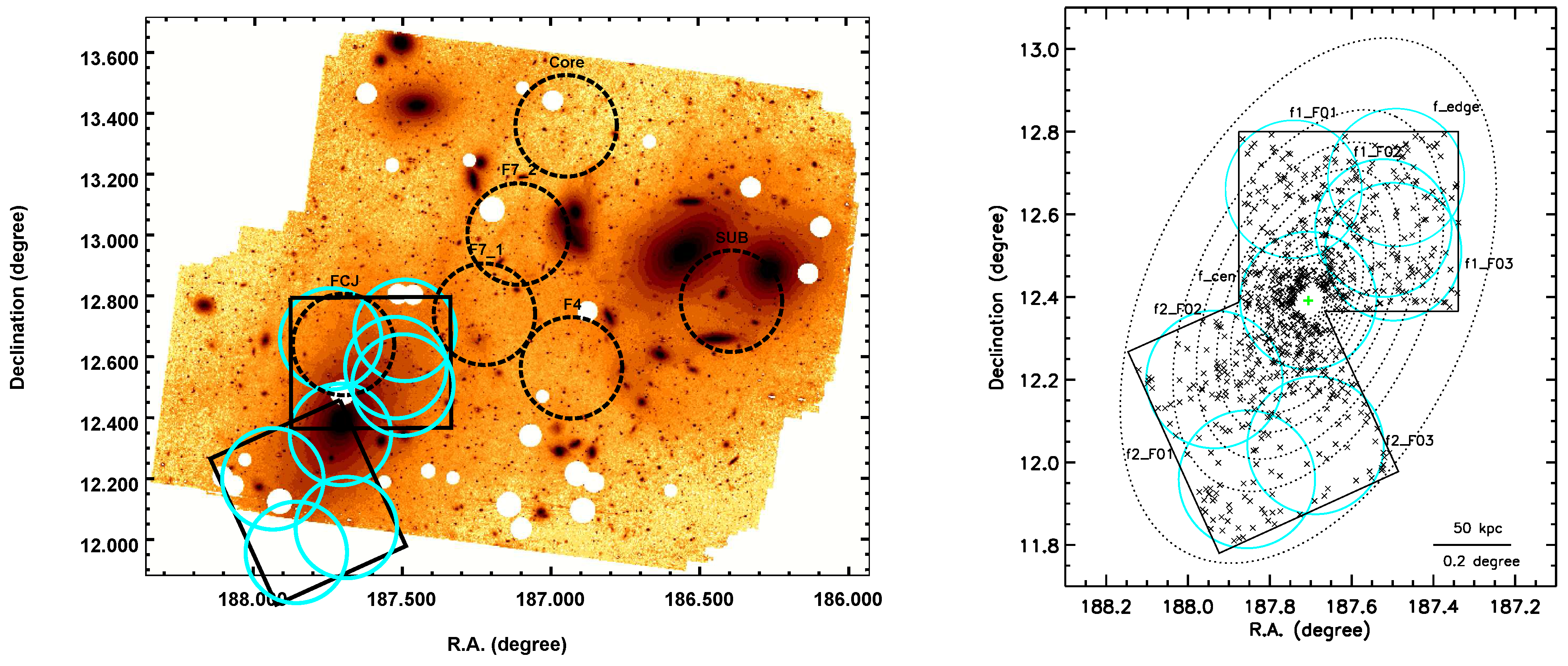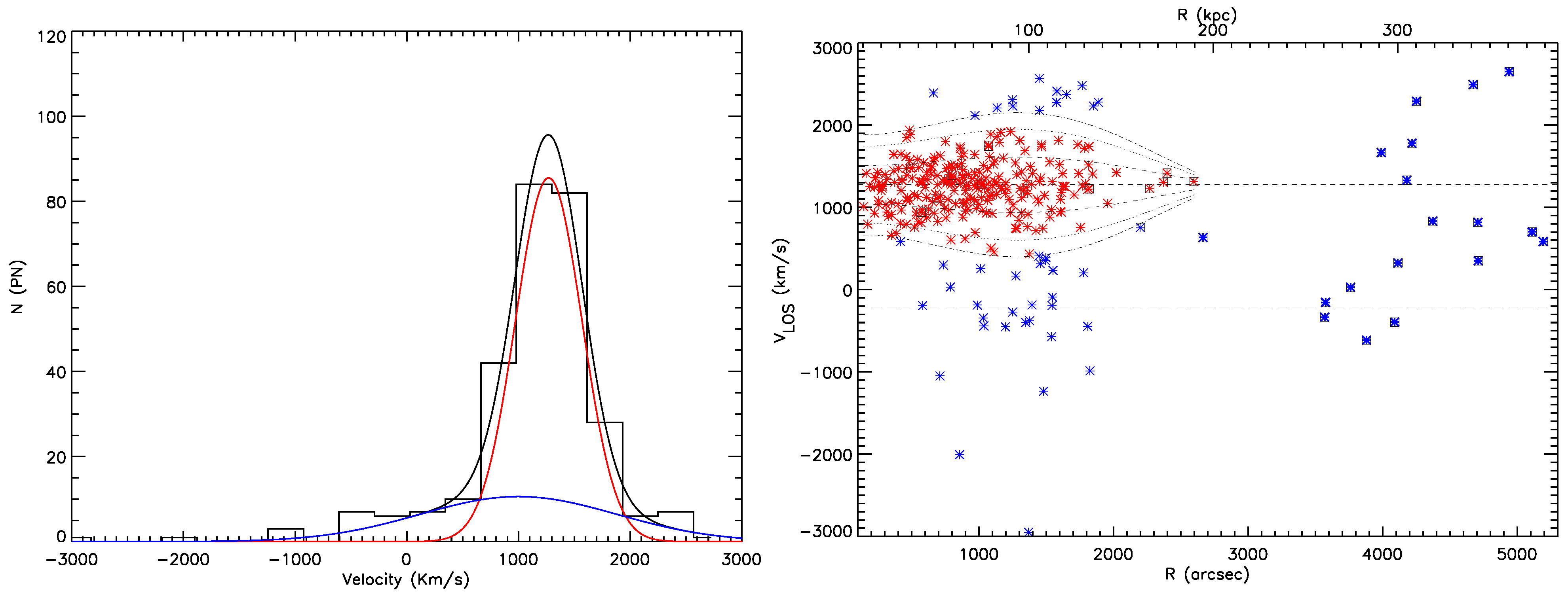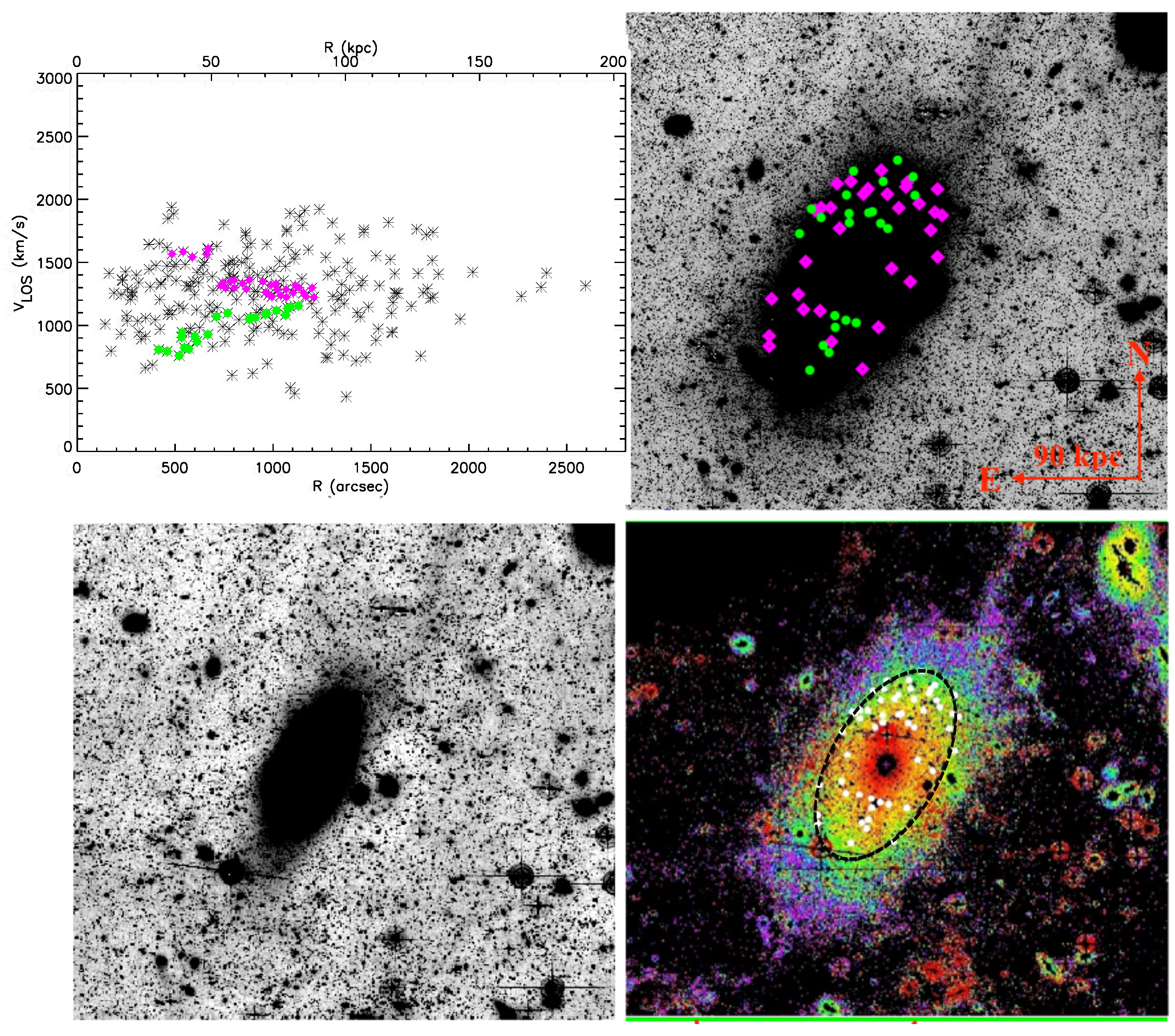The Ongoing Growth of the M87 Halo through Accretion Events
Abstract
:1. Introduction
2. PN Photometric and Spectroscopic Surveys

3. The Virgo Cluster Core: Kinematic Separation between the M87 Stellar Halo and the ICL

The Ongoing Mass Assembly of the M87 Halo

4. Results and Discussion
Acknowledgments
Author Contributions
Conflicts of Interest
References and Notes
- De Lucia, G.; Blaizot, J. The hierarchical formation of the brightest cluster galaxies. Mon. Not. R. Astron. Soc. 2007, 375, 2–14. [Google Scholar] [CrossRef]
- Naab, T.; Johansson, P.H.; Ostriker, J.P. Minor Mergers and the Size Evolution of Elliptical Galaxies. Astrophys. J. 2009, 699, L178–L182. [Google Scholar] [CrossRef]
- Thomas, D.; Maraston, C.; Bender, R.; Mendes de Oliveira, C. The Epochs of Early-Type Galaxy Formation as a Function of Environment. Astrophys. J. 2005, 621, 673–694. [Google Scholar] [CrossRef]
- Oser, L.; Ostriker, J.P.; Naab, T.; Johansson, P.H.; Burkert, A. The Two Phases of Galaxy Formation. Astrophys. J. 2010, 725, 2312–2323. [Google Scholar] [CrossRef]
- Laporte, C.F.P.; White, S.D.M.; Naab, T.; Gao, L. The growth in size and mass of cluster galaxies since z = 2. Mon. Not. R. Astron. Soc. 2013, 435, 901–909. [Google Scholar] [CrossRef]
- Cooper, A.P.; Gao, L.; Guo, Q.; Frenk, C.S.; Jenkins, A.; Springel, V.; White, S. Surface photometry of brightest cluster galaxies and intracluster stars in ΛCDM. Mon. Not. R. Astron. Soc. 2015, 451, 2703–2722. [Google Scholar] [CrossRef]
- Mihos, J.C.; Harding, P.; Feldmeier, J.; Morrison, H. Diffuse Light in the Virgo Cluster. Astrophys. J. 2005, 631, L41–L44. [Google Scholar] [CrossRef]
- Duc, P.-A.; Cuillandre, J.-C.; Karabal, E.; Cappellari, M.; Alatalo, K.; Blitz, L.; Bournaud, F.; Bureau, M.; Crocker, A.F.; Davies, R.L.; et al. The ATLAS3D project - XXIX. The new look of early-type galaxies and surrounding fields disclosed by extremely deep optical images. Mon. Not. R. Astron. Soc. 2015, 446, 120–143. [Google Scholar] [CrossRef]
- Bullock, J.S.; Johnston, K.V. Tracing Galaxy Formation with Stellar Halos. I. Methods. Astrophys. J. 2005, 635, 931–949. [Google Scholar] [CrossRef]
- Dopita, M.A.; Jacoby, G.H.; Vassiliadis, E. A Theoretical Calibration of the Planetary Nebular Cosmic Distance Scale. Astrophys. J. 1992, 389, 27–38. [Google Scholar] [CrossRef]
- Ventimiglia, G.; Arnaboldi, M.; Gerhard, O. The unmixed kinematics and origins of diffuse stellar light in the core of the Hydra I cluster (Abell 1060). Astron. Astrophys. 2011, 528, A24. [Google Scholar] [CrossRef]
- Gerhard, O.; Arnaboldi, M.; Freeman, K.C.; Kashikawa, N.; Okamura, S.; Yasuda, N. Detection of Intracluster Planetary Nebulae in the Coma Cluster. Astrophys. J. 2005, 621, L93–L96. [Google Scholar] [CrossRef]
- Kormendy, J.; Fisher, D.B.; Cornell, M.E.; Bender, R. Structure and Formation of Elliptical and Spheroidal Galaxies. Astrophys. J. 2009, 182, 216–309. [Google Scholar] [CrossRef]
- Rudick, C.S.; Mihos, J.C.; Harding, P.; Feldmeier, J.J.; Janowiecki, S.; Morrison, H.L. Optical Colors of Intracluster Light in the Virgo Cluster Core. Astrophys. J. 2010, 720, 569–580. [Google Scholar] [CrossRef]
- Longobardi, A.; Arnaboldi, M.; Gerhard, O.; Hanuschik, R. The outer regions of the giant Virgo galaxy M87 Kinematic separation of stellar halo and intracluster light. Astron. Astrophys. 2015, 579, A135. [Google Scholar] [CrossRef]
- Longobardi, A.; Arnaboldi, M.; Gerhard, O.; Hanuschik, R. The planetary nebula population in the halo of M 87. Astron. Astrophys. 2013, 558, A42. [Google Scholar] [CrossRef]
- Castro-Rodriguéz, N.; Arnaboldi, M.; Aguerri, J.A.L.; Gerhard, O.; Okamura, S.; Yasuda, N.; Freeman, K.C. Intracluster light in the Virgo cluster: Large scale distribution. Astron. Astrophys. 2009, 507, 621–634. [Google Scholar] [CrossRef]
- Doherty, M.; Arnaboldi, M.; Das, P.; Gerhard, O.; Aguerri, J.A.L.; Ciardullo, R.; Feldmeier, J.J.; Freeman, K.C.; Jacoby, G.H.; Murante, G. The edge of the M 87 halo and the kinematics of the diffuse light in the Virgo cluster core. Astron. Astrophys. 2009, 502, 771–786. [Google Scholar] [CrossRef]
- Gerhard, O.E. Line-of-sight velocity profiles in spherical galaxies: Breaking the degeneracy between anisotropy and mass. Mon. Not. R. Astron. Soc. 1993, 265, 213–230. [Google Scholar] [CrossRef]
- Bender, R.; Saglia, R.P.; Gerhard, O.E. Line-of-sight velocity distributions of elliptical galaxies. Mon. Not. R. Astron. Soc. 1994, 269, 785–813. [Google Scholar] [CrossRef]
- Longobardi, A.; Arnaboldi, M.; Gerhard, O.; Mihos, J.C. The build-up of the cD halo of M 87: Evidence for accretion in the last Gyr. Astron. Astrophys. 2015, 579, L3. [Google Scholar] [CrossRef]
- This figure is from the paper by Mihos et al., which is still in preparation.
- Dolag, K.; Murante, G.; Borgani, S. Dynamical difference between the cD galaxy and the diffuse, stellar component in simulated galaxy clusters. Mon. Not. R. Astron. Soc. 2010, 405, 1544–1559. [Google Scholar] [CrossRef]
- Cui, W.; Murante, G.; Monaco, P.; Borgani, S.; Granato, G.L.; Killedar, M.; de Lucia, G.; Presotto, V.; Dolag, K. Characterizing diffused stellar light in simulated galaxy clusters. Mon. Not. R. Astron. Soc. 2014, 437, 816–830. [Google Scholar] [CrossRef]
© 2015 by the authors; licensee MDPI, Basel, Switzerland. This article is an open access article distributed under the terms and conditions of the Creative Commons Attribution license (http://creativecommons.org/licenses/by/4.0/).
Share and Cite
Longobardi, A.; Arnaboldi, M.; Gerhard, O. The Ongoing Growth of the M87 Halo through Accretion Events. Galaxies 2015, 3, 212-219. https://doi.org/10.3390/galaxies3040212
Longobardi A, Arnaboldi M, Gerhard O. The Ongoing Growth of the M87 Halo through Accretion Events. Galaxies. 2015; 3(4):212-219. https://doi.org/10.3390/galaxies3040212
Chicago/Turabian StyleLongobardi, Alessia, Magda Arnaboldi, and Ortwin Gerhard. 2015. "The Ongoing Growth of the M87 Halo through Accretion Events" Galaxies 3, no. 4: 212-219. https://doi.org/10.3390/galaxies3040212
APA StyleLongobardi, A., Arnaboldi, M., & Gerhard, O. (2015). The Ongoing Growth of the M87 Halo through Accretion Events. Galaxies, 3(4), 212-219. https://doi.org/10.3390/galaxies3040212




